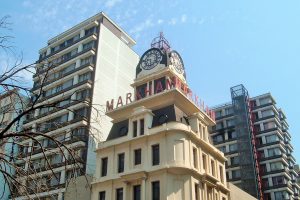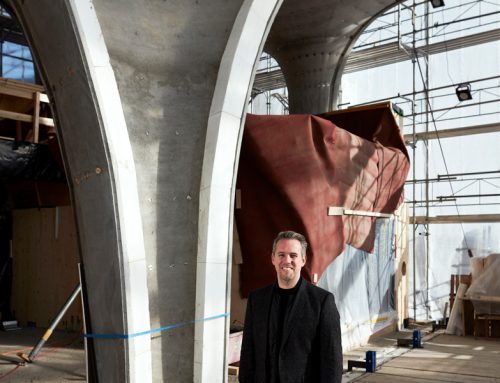 Heritage. Whose heritage? Why preserve Heritage? These are major issues in contemporary South Africa and something that Wits alumnus James Ball (BA Hons 2011; MA 2012) daily explores.
Heritage. Whose heritage? Why preserve Heritage? These are major issues in contemporary South Africa and something that Wits alumnus James Ball (BA Hons 2011; MA 2012) daily explores.
“Joburg is my spiritual home. I love this city. I love walking the streets, exploring the city and finding its hidden heritage secrets,” says James Ball, founder and editor of the online Heritage Portal. (www.theheritageportal.co.za)
It is a compelling site that delves into all the questions, dilemmas, tragedies, triumphs and circles within circles of South African heritage.
I spend time exploring Joburg with Ball who weaves me back and forth across the city’s spaces and places – from the relics and ruins of the first inhabitants to the 19th century Markhams clock tower in Eloff Street.
“The City of Joburg today is a mere 130 years old but people have been living in this region from about thousands of years ago,” James explains from our starting point on the top of Northcliff Hill.
Here, traces of Stone Age settlements and their tools are still visible. Their tools have also been unearthed right next to Joburg’s Supreme Court building in the inner city where we head next to explore the six-storey Markhams building and clock tower, built in 1897. Commissioned by Mr WH Markham, it was the tallest building in Joburg at the time.
“Built one decade after gold was discovered, it showed confidence in the fledgling town at a time when much of the world thought it was just a mining camp, a gold rush flash-in-the-pan that, sooner rather than later, would be abandoned,” Ball explains.
The Clock Tower is Ball’s godchild. “I have always been drawn to it and so I did my Honours on how the Markhams clock tower and building survived. I looked into its history and the building’s history and how it was almost demolished in the 1970s when the owners wanted to expand the on-site Markhams store.”
The citizens of Joburg came out in huge protest and lobbied the owners of Markhams and the municipality to stop the destructive plans. As a result, the clock tower and the façade of the building survive to this day, when so many others have been lost.
He is hoping that one day the more than R1million required to restore the clock and tower will be raised so that the bells may ring out again, alerting the city to the time of day and reminding its citizens of the swift passing of time.
One of Joburg’s lost architectural treasures was the magnificent 2279-seater Colosseum Theatre, which opened in 1933. A prominent architect at the time, Percy Rogers Cooke designed the exterior, while William Timlin, an artist from Kimberley, designed the interior, with its castle turrets and Spanish Renaissance style.
An excellent article published in the Heritage Portal, authored by Kathy Munro, describes how this “cinema fantasy of the thirties” was closed in 1985 by the owners, the Prudential Assurance Company, demolished “and lost forever in a flash”.
In its place an office block bearing the name Colosseum was built, which has since been converted into the 10-storey residential block it is today. Adaptive re-development of the original building as a mixed use complex with a theatre, concert, convention centre, offices and shops would have been a far better option and one that was fought for at the time, but this battle was lost.
“The history of Joburg is that it developed so quickly that for any building to have survived is a miracle,” Ball explains as we burrow through the inner city streets where another interesting heritage debate has emerged. This debate is addressing the gender sensitive re-naming of inner city streets to honour four women liberation icons and new recipients of the Freedom of the City award.
- Bree Street is to become Lilian Ngoyi Street
- Jeppe Street is to become Rahima Moosa Street
- President Street is to become Helen Joseph Street
- Noord Street is to become Sophie de Bruyn Street
Sophie de Bruyn is the only living member of the four.
The re-namings were widely debated by the City of Joburg which took into consideration the inputs from the Johannesburg Heritage Foundation (JHF). It was decided, for example, that certain streets, such as Pritchard Street should retain their original names. An excerpt from the City’s response to the JHF reads as follows:
“As stated by the JHF, it is desirable to remember the contribution of William Henry Auret Pritchard (1861-1947), an early surveyor of Johannesburg. Pritchard moved to Johannesburg on 25 August 1886, arriving before the proclamation of the goldfields, and took up work as a surveyor. Pritchard continued to work as a surveyor in the city until 1957 played a leading role in the establishment of the Institute of Land Surveyors of the Transvaal.”
The politics of heritage are extremely complex as the current monuments campaign and certain acts of vandalism attest. Who should stay and who should go? Prominent statues of prominent people in South Africa’s good, bad and ugly history are at the heart of this, but, as Ball explains, heritage is not just about the major players and massive moments in our history; it is as much about the ordinary people, who they were, where they lived, what they thought and what they did.
“My Master’s through the Department of History at Wits afforded me the opportunity to inform my understanding of heritage and to study under some of the best minds in the business,” he says. “It ultimately provided me with the platform to embark on the Heritage Portal journey.”
He is particularly appreciative of the guidance he received from Professor Clive Glaser and Professor Noor Nieftagodien, both from the Wits History Department. “I am privileged to have been able to work so closely with such inspiring and exceptional men.”
Prof Nieftagodien convincingly argues for recognition of the ordinary person’s history and heritage.
“This often gets neglected in the post-1994 emphasis on the country’s liberation struggle and its leaders,” says Professor Noor Nieftagodien who heads up the History Workshop and the NRF/SARChI Chair in Local Histories and Present Realities.
“If we don’t take the trouble to research and record the everyday experiences of all people we cannot understand human agency: what drives people to do things or to remain inert. Historians need to move beyond only focusing on the big events because it is what happens between the big events that is so important,” he adds.
“Hence if we think of Orlando West in Soweto for example, we automatically think of Vilakazi Street, the only street in the world to have been home to two Nobel Laureates, Nelson Mandela and Desmond Tutu. This is part of our heritage, of course, but what about the ordinary people in Orlando West? Is Mrs Ntuli living in a nondescript house in Orlando West not as important to our heritage as is Mandela or Tutu?”
These are the key heritage questions that fascinate Ball, and why he admires the work done by the team at Wits’ Historical Papers Research Archives (www.historicalpapers.wits.ac.za). Situated in the William Cullen Library, it was established in 1966.
Historical Papers is one of the largest and most comprehensive independent archives in southern Africa. It houses over 3300 collections of historical, political and cultural importance, from the mid 17th century to the present. Its primary aim is to serve the broader community as well as the university and to transform archives into accessible centres for research.
Ball describes the team at Historical Papers as “a delight to work with”.
“Their positive energy and stimulating conversations make every visit thoroughly worthwhile. I could lose myself for weeks in the archives, reading up on people and places in and around Joburg that have shaped the city’s past and present.”
The old Pass Office in downtown Joburg is one example. “This was the nerve centre that controlled every aspect of a black person’s life in Joburg in the 1950s and 1960s. It is still there today and it currently serves as a women’s shelter, but the extremely important history and heritage of this place is little known.”
Ball explains that all sites and buildings that qualify as ‘heritage’ or are recognised as significant places and spaces are entitled to use the heritage ‘blue plaque’. “Many important sites and buildings throughout the country still need to be nominated and declared as heritage sites,” he explains.
Another aspect of heritage he raises is that any building or home older than 60 years anywhere in South Africa now has to be approved for any kind of renovation or development by the Provincial Heritage Resources Authority of Gauteng (PHRAG).
Ball explains that PHRAG is completely underresourced so there are often delays. His dream would be to have an online interactive heritage database that flags important information at the beginning of any planning process. This would be of interest to owners and developers and it would help to lighten the burden on overloaded officials.
Members of the Johannesburg Heritage Foundation are working on this but they are predominantly volunteers, including Ball, who teaches history at the International Pre-University College to afford his heritage commitments, including editing the Heritage Portal.
The site currently has over 20 000 readers per month, South African and global. Ball encourages anyone who would like to contribute to contact him. “You might remember something about Joburg or other parts of South Africa that people would be interested to read, or you might want to ask questions about a particular aspect of South Africa’s heritage. As a fellow Witsie it would be wonderful to hear from you.”
To contact James Ball:
ends




